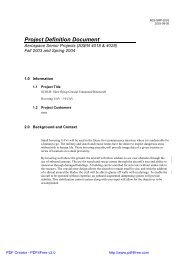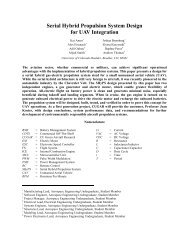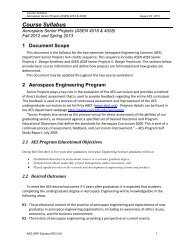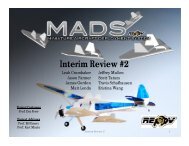PFR - Aerospace Engineering Sciences Senior Design Projects ...
PFR - Aerospace Engineering Sciences Senior Design Projects ...
PFR - Aerospace Engineering Sciences Senior Design Projects ...
Create successful ePaper yourself
Turn your PDF publications into a flip-book with our unique Google optimized e-Paper software.
Project Final Report – CUDBF April 30 th , 2009<br />
ASEN 4028: <strong>Aerospace</strong> <strong>Senior</strong> <strong>Projects</strong><br />
distance and risk going off the runway and destroying the aircraft. The flight was not scrubbed<br />
because we could still gather the average battery power draw once airborne, and the pilot could<br />
still get experience flying at the maximum payload weight.<br />
The pilot was able to get airborne in 150 ft by slowly accelerating up to takeoff speed. Once<br />
airborne, the pilot did some maneuvering, flew one competition lap, and landed. The average<br />
power draw was 332 W, less than the 350 W of power draw. This was very significant because<br />
this proved that the aircraft could indeed make the four lap range with the full water bottle<br />
payload. A plot of power usage versus time is shown in Figure 138.<br />
800<br />
Power Usage<br />
700<br />
600<br />
Power Usage (W)<br />
500<br />
400<br />
300<br />
200<br />
100<br />
0<br />
0 20 40 60 80 100 120 140 160<br />
Time (seconds)<br />
Figure 138: Power draw for full water bottle payload flight<br />
13.2.2.13 Flight Test #20<br />
The goal of flight test #20 was to fly the aircraft with what would be the best case single rocket<br />
asymmetric load; one rocket inboard on one wing, and no rockets on the other wing. This led to a<br />
lateral CG shift of 4.0”.<br />
On takeoff roll, there was a strong pull to the left (the side on which the asymmetric rocket was<br />
placed). The aircraft almost went off the runway, so the pilot applied full up elevator in order to<br />
lift off before going off the runway. The aircraft rolled more than 90°, stalled, and impacted the<br />
ground. The left wingtip was broken in half, along with damaged motor mounts and propellers.<br />
The cause of the accident was traced to the fact that the asymmetric load on one wingtip caused<br />
one of the main gear to compress significantly, causing the aircraft to pull to the left and almost<br />
go off the runway. The full up elevator applied in order to make the aircraft takeoff only<br />
exacerbated the turn and led to the stall. The pilot also regretted not using opposite aileron during<br />
151
















